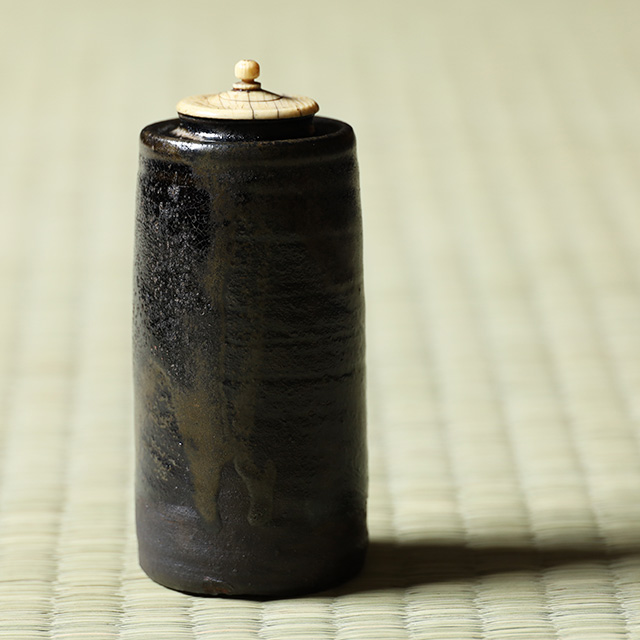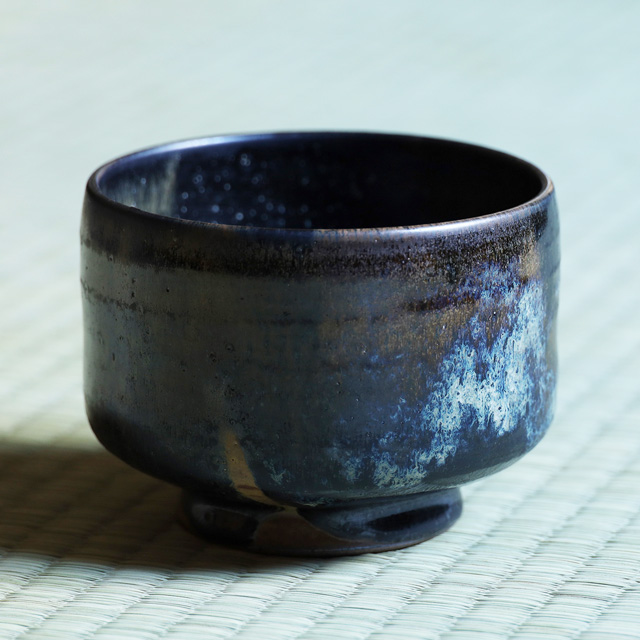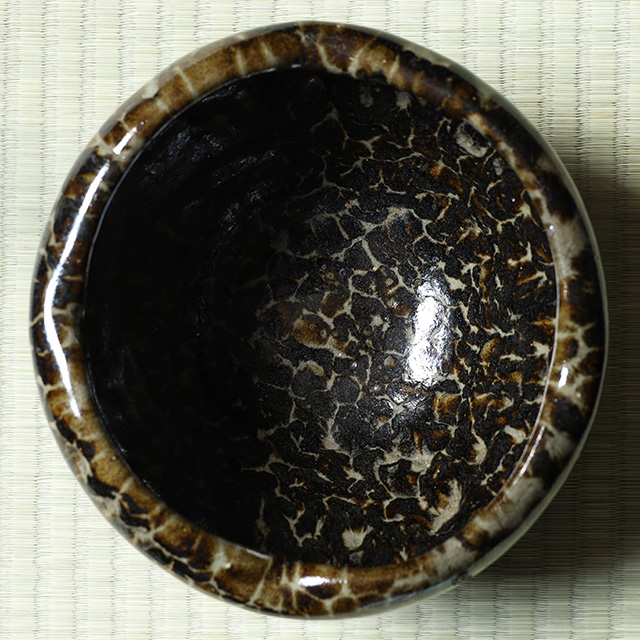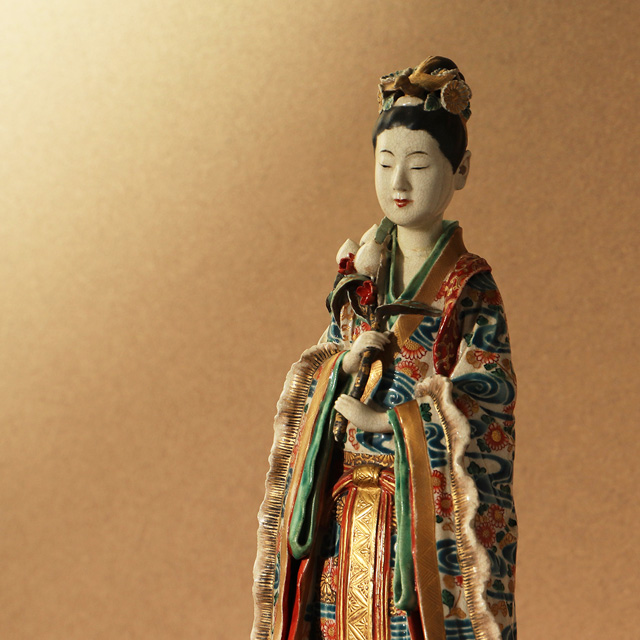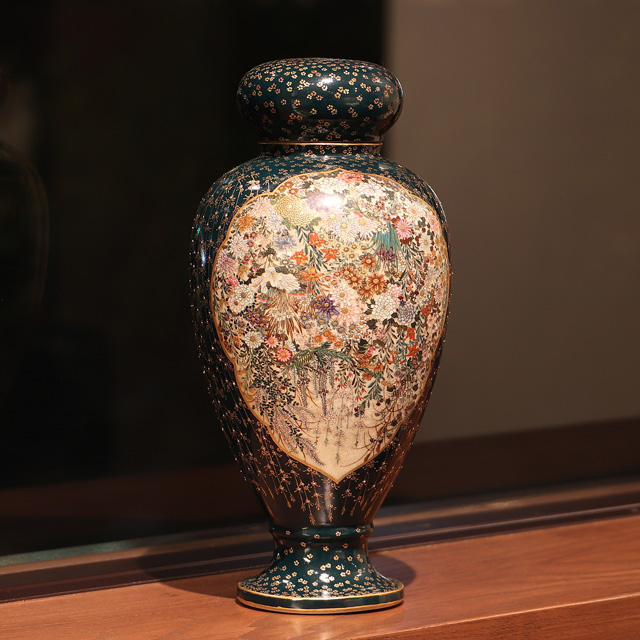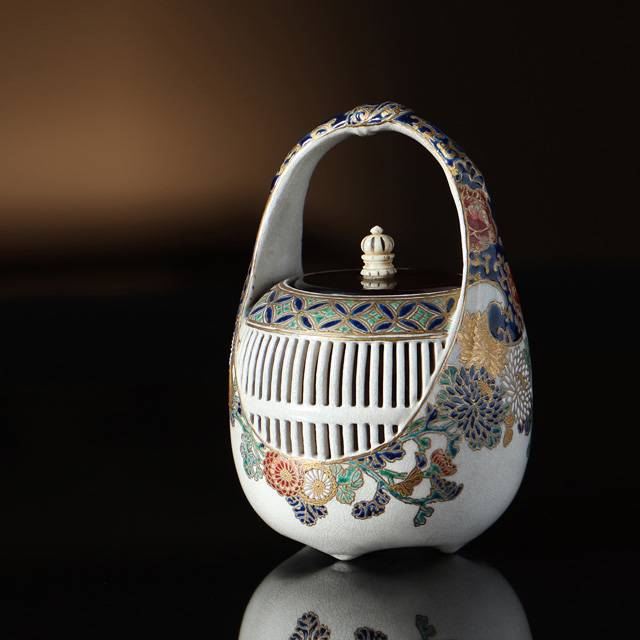Satsuma Ware
薩摩焼

https://tenpyodo.com/en/product1/cat/japanease-en/(Fine Arts ⇒ Japanese Antique)
薩摩焼
薩摩焼とは薩摩国鹿児島藩島津家の庇護の下に御用焼として焼成された陶磁器です。
桃山時代における特筆すべき文化の一つは千利休による茶道確立と侘び茶の流行です。
利休門下の茶人として知られる17代当主・島津義弘も自領内での茶陶焼成を試みました。
文禄・慶長の役で朝鮮半島から陶工を召致してきた事が開窯の契機となっています。
薩摩焼諸窯は主に竪野焼、苗代川焼、元立院焼、龍門司焼、平佐焼に大別されています。
庶民用の「黒薩摩(黒物)」と藩主用の「白薩摩(白物)」を主体とし、
古帖佐、火計り手、宋胡録手、蛇蝎釉、鮫肌焼、錦手(金襴手)等の多彩な種類が知られます。
18世紀には平佐焼が興り、色絵や染付を中心とした華麗な装飾磁器が展開されました。
豪華絢爛の錦手は竪野系(藩窯)の窯で開発が進められ、19世紀に入って隆盛を極めました。
1855(安政2)年に28代当主・島津斉彬は、
鹿児島市吉野町磯の別邸内に磯窯(磯御庭焼)を開窯しました。
斉彬は富国強兵・殖産興業を目的とした集成館事業として、
薩摩焼においても苗代川焼の朴正官を召致して試験改良や開発研究に従事させた結果、
白盛絵具の実用化や金盛技法の確立によって錦手の完成に大きく寄与しました。
1857(安政4)年には薩摩藩営陶磁器製造所の支部が苗代川に設立され、
12代沈壽官が磁器方主取に任命されました。
磯窯は1863(文久3)年の薩英戦争で閉窯しました。
この薩英戦争を機に薩摩国と英国は協定を結びます。
1858(安政5)年に江戸幕府はアメリカとの間に日米修好通商条約を締結し、
次いで、オランダ、ロシア、イギリス、フランスとも修好通商条約を締結しました。
1859(安政6)年に長崎港、函館港(北海道)、横浜港(神奈川県)が開港され、
1868(明治元)年に神戸港(兵庫県)、新潟港が開港されると諸外国との貿易が開始されました。
1867(慶応3)年、鹿児島藩は朴正官の「錦手花瓶」をパリ万国博覧会に出品しました。
更に1873(明治6)年のウィーン万国博覧会に出品された12代沈壽官の錦手が好評を博し、
名声は飛躍して世界を市場にした薩摩焼の大盛況時代を迎えました。
この華麗な装飾陶器は「SATSUMA」の商標で輸出され、欧米諸国で特に愛好されました。
このように好評を博した事から其々の土地でも薩摩風陶器は生産され、
「本薩摩」に対し、「京薩摩」、「大阪薩摩」、「横浜薩摩」、「東京薩摩」等と呼ばれています。
しかし、1897(明治30)年前後から急速に人気を落として衰退の傾向を辿り、
大正年間(1912~26)には欧米諸国の需要を殆ど失いました。
要因は大量生産による粗製乱造であったとされています。
近代、錦手は主な輸出先であった欧米諸国から相次いで里帰りしています。
現在は15代沈壽官氏を中心とし、その伝統を受け継いでいます。
Hirasa Ware
Hirasa ware is porcelain fired in Amatatsu-cho, Satsumasendai City, Kagoshima Prefecture. In 1776, Giemon Imai opened the “wakimoto kiln”, but after about two years it was closed due to financial difficulties. Later, in 1786(Tenmei 6), Danemon Ijichi called a potter from hizen under the patronage of the feudal lord Hisatsura Hongo and opened the “hongo kiln” in earnest. This area was close enough to transport amakusa porcelain stone, which was the raw material, and the convenient location facing sendai bay was in place for shipping products. After the 18th century, when amakusa porcelain stone was distributed as a raw material for porcelain, porcelain kilns were born all over Kyushu. The purpose of establishing porcelain kiln in satsuma province was to suppress the influx of hizen porcelain and promote industrial development. Hirasa ware uses amakusa porcelain stone, so the base is white and resembles hizen porcelain. In 1810(Bunka 7), “hirasa large kiln” was opened. In 1846(Koka 3), an overglaze kiln was added, and in 1848(Kaei 1), a new kiln was added. The business got on track and expanded sales channels not only within the domain, but also to Amami Oshima and the Ryukyu area, prospering. In 1861(Bunkyu 1), learned the preparation method of gosu from Owari-ya Jozo and others in Kyoto, and in 1865 (Keio 1), Nagayo pottery artist Sojuro Aoki introduced the technique of hirasa sansai. In 1867(Keio 3), it is said that he obtained the cooperation of the French trader Condo de Montblanc. At the end of the Tokugawa shogunate, the road to overseas exports was opened, but in the first year of the Meiji era, many of the works transported to Nagasaki for export were destroyed by fire. In 1871(Meiji 4), it lost the patronage of the Hongo clan due to the abolition of feudal domains and establishment of prefectures. In 1875(Meiji 8), the large kiln was rebuilt, but with the influx of hizen porcelain, it gradually declined.In 1941, Kanbe Mukai, who was celebrated as a master craftsman, passed away, marking the end of hirasa ware.
We sell and purchase Satsuma Ware
We have a physical shop in Hakata-ku, Fukuoka City, where we sell and purchase "Satsuma Ware" works. Drawing on a long career and rich experience in dealing, we promise to provide the finest service in the best interests of our customers. With the main goal of pleasing our customers, we will serve you with the utmost sincerity and responsibility until we close the deal.



